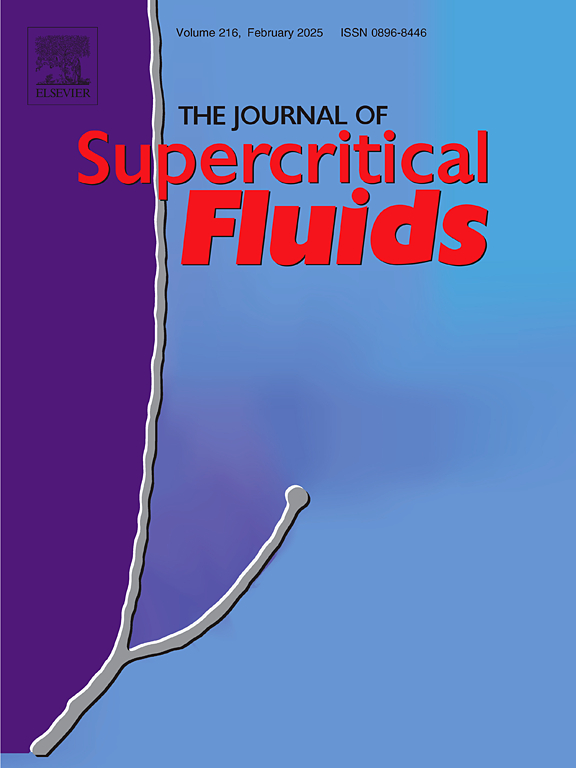Optimized production of Yellow 2G nanoparticles via supercritical gas anti-solvent process for advanced application in supercritical dyeing
IF 4.4
3区 工程技术
Q2 CHEMISTRY, PHYSICAL
引用次数: 0
Abstract
High-quality, efficient dye and pigment nanoparticles are ideal for supercritical dyeing in the textile industry, an eco-friendly and water-free dyeing method. This study investigates the precipitation of Yellow 2G nanoparticles, an azo dye, via the supercritical gas anti-solvent (GAS) process under varying pressures (10 MPa, 12.5 MPa, and 15 MPa), solute concentrations (0.1 mg.ml−1, 0.3 mg.ml−1, and 0.5 mg.ml−1), and temperatures (308 K, 318 K, and 328 K), using the Box-Behnken design (BBD) approach. Results indicated that higher pressure, lower temperature, and reduced solute concentration favor the formation of uniform Yellow 2G nanoparticles. In this study, nanoparticles ranging from 168.8 nm to 760.8 nm were successfully generated, with 318 K, 15 MPa, and an initial concentration of 0.1 mg.ml−1 identified as the optimal conditions. The features of the produced nanoparticles were assessed through HPLC, FESEM, XRD, DSC, and FTIR analyses. HPLC analysis confirmed the purity of the produced nanoparticles, while XRD and DSC results indicate a decrease in crystallinity and particle size. Additionally, FESEM observations verified that the precipitated dye particles were within the nano-scale range.
超临界气体抗溶剂工艺优化制备黄色2G纳米颗粒,用于超临界染色
高品质、高效的染料和颜料纳米颗粒是纺织工业超临界染色的理想选择,是一种环保、无水的染色方法。本文研究了在不同压力(10 MPa、12.5 MPa和15 MPa)、溶质浓度(0.1 mg)下,超临界气体反溶剂(gas)工艺对偶氮染料黄色2G纳米颗粒的沉淀。0.3毫升− 毫克。ml−1和0.5 mg.ml−1),温度(308 K, 318 K和328 K),使用Box-Behnken设计(BBD)方法。结果表明,较高的压力、较低的温度和较低的溶质浓度有利于形成均匀的黄色2G纳米颗粒。本研究成功制备了168.8 nm ~ 760.8 nm范围内的纳米颗粒,初始浓度为0.1 mg,初始温度为318 K, 15 MPa。Ml−1确定为最佳条件。通过HPLC、FESEM、XRD、DSC和FTIR分析对制备的纳米颗粒进行了表征。HPLC分析证实了制备的纳米颗粒的纯度,而XRD和DSC结果表明结晶度和粒径都有所下降。此外,FESEM观察证实,沉淀的染料颗粒在纳米级范围内。
本文章由计算机程序翻译,如有差异,请以英文原文为准。
求助全文
约1分钟内获得全文
求助全文
来源期刊

Journal of Supercritical Fluids
工程技术-工程:化工
CiteScore
7.60
自引率
10.30%
发文量
236
审稿时长
56 days
期刊介绍:
The Journal of Supercritical Fluids is an international journal devoted to the fundamental and applied aspects of supercritical fluids and processes. Its aim is to provide a focused platform for academic and industrial researchers to report their findings and to have ready access to the advances in this rapidly growing field. Its coverage is multidisciplinary and includes both basic and applied topics.
Thermodynamics and phase equilibria, reaction kinetics and rate processes, thermal and transport properties, and all topics related to processing such as separations (extraction, fractionation, purification, chromatography) nucleation and impregnation are within the scope. Accounts of specific engineering applications such as those encountered in food, fuel, natural products, minerals, pharmaceuticals and polymer industries are included. Topics related to high pressure equipment design, analytical techniques, sensors, and process control methodologies are also within the scope of the journal.
 求助内容:
求助内容: 应助结果提醒方式:
应助结果提醒方式:


